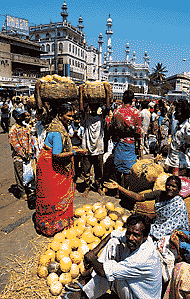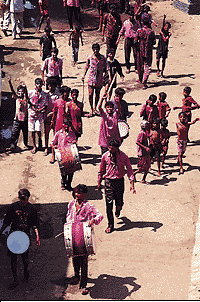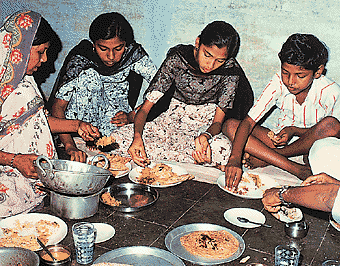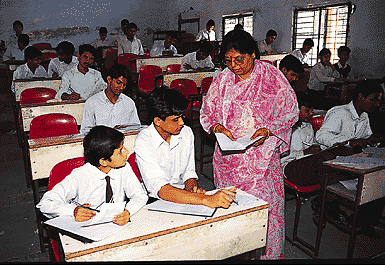Although a great deal of modernization has taken place in India, many people still follow traditional ways of life. For example, most Indian weddings are followed by a lively procession through the streets accompanying the bridegroom to the bride's house.
Family life. Family ties have great importance in India. Indians regard marriage as more of a relationship between two families than between two people. Young Indians generally are not allowed to have dates, and parents arrange most marriages. However, many young people now choose their own partners. Many Indian households include not only parents and children, but also the sons' wives and their children.
(Top)
Village life. Most Indian villages consist of mud-and-straw huts crowded together. A few richer villagers live in brick homes. Indian farmers do not live on their land. The farmland lies near their villages, and farmers go out to the fields to grow food for their families. Village homes have mud floors and only one or two rooms. The people sit and sleep on beds of woven string. The few household articles include brass pots for cooking and clay pots for carrying water and storing food.
Many village homes have no running water or electricity. The women get water from the one or two village wells. They pour it into pots, which they carry home on their heads. About half of India's villages have access to electricity, though individual homes may not use it. Many Indian families have paraffin lanterns.
Most Indian villages have a one- or two-room school but no post office or shops. The villagers trade at a nearby market town, or at a roadside spot where they meet once a week. Most villages are governed by panchayats (councils of elders elected by all adults).
Rapid economic growth has greatly improved some parts of village life. For example, the Indian government has increased agricultural production in such states as Haryana and Punjab. In these areas, many villages have electricity, improved drinking water and sanitation, and more schools and paved roads.
(Top)

- Bangalore street market
City life. As in most countries, India's larger cities are centres of business, political, and university activities. But many city dwellers keep their ties with the village from which they or their ancestors came.
Varanasi and certain other Indian cities were commercial, political, and religious centres in ancient times. Some had sacred temples that attracted pilgrims from all over the country. By the early 1800's, however, three ports founded by Europeans--Bombay (now Mumbai), Calcutta, and Madras (now Chennai)--had become the country's major cities. Many Indian cities developed two different areas, a British section and an Indian section. Rich Indians and Indians of high military or political rank now live in the former British sections. These areas show a strong Western influence. They have modern buildings, shopping districts with large stores, and wide, tree-lined streets. The people live mostly in pleasant one- or two-storey houses.
In the Indian sections of the cities, buildings cover almost all of the land. Bicycles, carts, animals, and people fill the narrow streets. Small shops with open fronts line the streets. Families live behind and above the shops. These families include not only the very poor, but also some rich people who prefer the older ways of life.
The cities of India have large slums and squatter populations. Thousands of slum dwellers sleep in the streets because they have no homes. Others live in shelters made of scraps of wood or metal. Most Indian slum buildings have at least one whole family, and often more, living in a small room. The women cook on the floor. Many slum dwellings have no chimneys or even windows to remove the smoke. The slum areas have poor water supplies and sanitation. Many of these areas have no public sanitation at all. Since the early 1970's, the Indian government has replaced many slum buildings with low-cost public housing.
Even the better sections of the cities have frequent electric power failures, and water stoppages often occur for hours. Many homes have a reserve water tank on the roof for the dry hours.
(Top)
Religion. About 83 per cent of the Indian people are Hindus, and about 11 per cent are Muslims. The next largest religious groups, in order of size, are Christians, Sikhs, Buddhists, and Jains.
Religion plays a vital role in the Indian way of life. Religious laws of the Hindus and Muslims govern the people's clothing, food, and marriage. They also strongly influence the type of occupation among people who strictly follow the laws. Ethnic and political differences between Hindus and Muslims led to the division of India into two nations, India and Pakistan. Many thousands of Indians have died in fighting between Hindus and Muslims. Killings still occur from time to time.
Hinduism is the world's oldest major religion. It has no single founder or head. Hindus believe that the soul never dies. After the body dies, the soul is reborn in another life form. This process is repeated until the soul reaches spiritual perfection, or salvation. Then, the soul enters a higher state of existence from which it never returns. Hindus follow the principle of ahimsa, noninjury to living creatures. This principle especially applies to cows, which Hindus believe are sacred animals. As a result, hardly any Hindus eat beef, and many do not eat any kind of meat.
Hindus worship many divinities (gods and goddesses). The three most important ones are Brahma, the creator of the universe; Vishnu, its preserver; and Shiva, its destroyer. Hinduism has a number of sacred writings, such as the Vedas, Upanishads, and Puranas. They outline how its followers should conduct their lives.
Hindus are divided into thousands of social groups called castes. The castes are grouped into four main categories. These categories, from the highest to the lowest, are Brahmans, Kshatriyas, Vaisyas, and Sudras. Each caste has a traditional occupation, such as priest, artist, or farmer. A Hindu is born into a caste and finds it impossible or extremely difficult to become a member of a higher caste. Within a community, a person's social status usually depends on his or her caste.
Each caste has its own rules of behaviour. These rules limit social contacts with members of other castes. Marriage between people of different castes seldom occurs. Each caste also has rules concerning who may cook the food its members eat. For example, people of a high caste may eat only food that is prepared by members of the same caste. Most Hindus will eat food prepared by members of a higher caste. Each caste also has customs regarding the type of food its members may eat. Some castes eat meat, and others eat fish but not meat. Some eat neither meat nor fish, but do eat eggs. Still others do not eat eggs. Generally, the higher castes have more restricted diets than the lower castes.
Education and modern industrial life have weakened many caste barriers. Today, Hindus of various castes mix freely in factories, offices, and public places. Many Indians want the caste system to die out. But many castes provide welfare and educational benefits to their needy members. Castes also help to pass on skills in arts and crafts from generation to generation.
For thousands of years, a group called the untouchables has existed outside the four main categories of caste and has ranked below the lowest Sudra caste. Untouchables make up about 20 per cent of the Indian population. Traditionally they have held the lowest jobs, such as street sweeper and leather worker. The 1950 Indian constitution, however, outlawed discrimination against untouchables and all lower castes and gave these people equal rights as full citizens. The government has provided scholarships, jobs, and other kinds of assistance for them. Seats are reserved for them in Parliament and the state assemblies. But many Hindus still believe in the old rules that keep these people in their low positions. These rules included restrictions that prevented untouchables from entering temples and drawing water from public wells.
Islam, the religion of the Muslims, is India's second largest religion. India has one of the largest Muslim populations in the world. Most Indian Muslims live in the northern part of the country. Some are descendants of Islamic peoples from western and central Asia. But most are descendants of Hindus who converted to Islam. Some continue many Hindu practices. Others follow the same practices as Muslims in Middle Eastern countries. The Muslims have been a powerful political and economic group in India for centuries.
Other religions. Christians total about 3 per cent of India's population. Many live in the state of Kerala, where they make up about a fifth of the population. Many of the peoples in the areas along India's northeastern border are Christians.
Sikhism began in about 1500 as a movement to combine Hinduism and Islam. Sikhs make up about 2 per cent of India's population. Most live in the north. They are the country's leading wheat farmers. Sikhs also form one of the largest groups in the army.
Buddhism ranked as India's chief religion in ancient times. Today, less than 1 per cent of the people practise Buddhism.
Jainism developed during the 500's B.C. Jains consider all life sacred and eat no meat. Some Jain priests wear cloths over their mouths to keep from breathing in an insect and killing it. About half of 1 per cent of all Indians practise Jainism. Most Jains live on the western coast. Many hold high positions in business and industry.
(Top)

- Hindu religious festival
Clothing worn by Indians varies greatly from region to region. Members of the various religious groups also may dress differently. But most Indians wear light, loose clothing because of the hot climate.
Some Indians, especially in the cities, wear Western-style clothing. But the clothing of many Indians consists of a long piece of cloth draped around the body. Many men wear a dhoti (a simple white garment wrapped around the legs). The dhoti forms a sort of loose trousers. Some men wrap the garment around themselves like a skirt. In northern India, some men wear long, tight coats with trousers. The trousers are wide at the top and fit tightly from knee to ankle. Many Indian men wear turbans of various shapes.
Most Indian women wear a sari (a straight piece of cloth draped around the body as a long dress). They place its loose end over the head or shoulder. Wealthy women may wear saris made of silk, with borders of gold thread. Many of the women of northern India wear pyjamas (full trousers) with a long blouse and a veil. Indian women usually wear some jewellery, especially earrings and bracelets. Many women also wear a kumkum (round dot) in the middle of the forehead. The kumkum, which is usually prepared from a red or black powder, is considered a mark of beauty.
(Top)
Food. The chief foods of India include rice, wheat, millet, and pulses. Pulses are the seeds of such pod vegetables as beans, chickpeas, pigeon peas, and lentils. A typical meal consists of rice and dal, a porridge made of pulses. Indians also enjoy wheat-flour chapatties, thin flat baked breads that resemble soft pancakes. Some other breads are made from rice or pulse flour. Samosas, deep-fried pastries stuffed with potatoes, vegetables, or meat, are popular snacks. A special meal might include chicken or lamb roasted in a clay oven called a tandoor. For special events, such as weddings, Indians may wrap elegant foods in a layer of silver so thin that it can be eaten.
Most Hindus do not eat beef, and some eat no meat at all. Muslims eat no pork. Indians enjoy carefully spiced vegetable dishes. They use many different spices and blend special mixtures for each dish. Indians eat many kinds of curries, which consist of vegetables, seafood, eggs, or meat cooked in a spicy sauce. One or more kinds of chutneys accompany many meals. Chutneys are relishes of spices and fruit, especially mangoes. As a cool contrast to spicy foods, Indians sometimes serve raita, a mixture of yoghurt with fruit and vegetables. Sweet desserts are made from milk, yoghurt, fruit, and nuts. Fresh fruit and fruit drinks are popular. Tea is a favourite beverage in India, but many southern Indians prefer coffee.
(Top)

- Family dinner in India
Health. The health of Indians is generally poor compared with that of Westerners. The country has a high death rate, partly because of poor diet and living conditions. India has done much to control the spread of such diseases as cholera and malaria. Since the 1950's, the government has been setting up nationwide public health services. It has built many new hospitals and clinics. Since 1950, the average life expectancy of Indians has risen by about 25 years.
(Top)
Education. About half of India's population over the age of seven years can read and write. This figure is well over double the percentage that could read and write during the early years of the nation's independence. The rising literacy rate has resulted from government education programmes that began in 1951. The government has spent much money to build schools, train teachers, and provide books and other educational materials. School attendance among all age groups has increased substantially since 1951.
The Indian Constitution provides for free education for children from age 6 to 14. Even though school is not compulsory, about 85 per cent of all children attend some of the first five years of primary education. But school attendance for higher grades totals only about 35 per cent. Rural areas have fewer schools and attendances than the cities, because many children drop out of school and get jobs to support their families.
India has more than 5,000 colleges and universities. About 4 per cent of people between 18 and 23 attend institutions of higher education.

- Public Education in India
 ( Back to top )
( Back to top )
